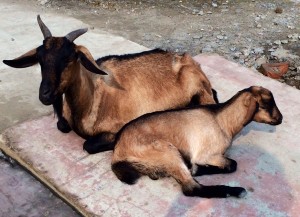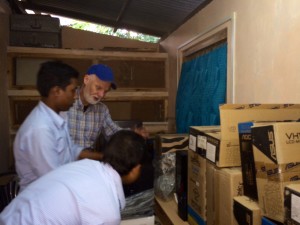Our original plan was to go to the schools on Monday. But there happened to be a district wide strike called. The schools are in Morigaon which is about 1.5-2 hours one way from Guwahati and traveling the long distance during the strike was not recommended.
We headed out on Tuesday and were completely floored at the welcome we received upon our arrival. As we arrived at the Morigaon Jatiya Vidyalaya school gate, we saw a beautiful banner the school had made welcoming Kids on Computers. The entire school was outside waiting for us. They greeted us with a small Puja and each of us received a hand-woven shawl with a design that is unique to Assam. As we saw the kids and their eager, smiling faces, I couldn’t help but get tears in my eyes.
Morigaon is a rural district with miles of beautiful farm land and rice paddies. Cows and goats roam the roads as if it were their own. It is also the poorest district in Assam and has a literacy rate of 69.37% as of 2011.
These computer labs have been a long time in the making and we are so happy to finally set them up. We first visited the room that had been set up for the computer lab. We determined the room was too small (we tested by having students come in and sit and saw that it would be difficult to have 12 computers running in there). We decided to use a larger room the school had. The school personnel and electrician proceeded to discuss what would need to take place in the next 2 days to convert the room into a computer lab.
After this discussion, we then visited each classroom and were greeted with a huge “Hi!” and “Namaskar!”. This school has classes from Kindergarten to 10th grade. There is one class for each grade, except for Kindergarten which has two, and approximately 15-30 students per class. The teachers had prepped the students and instructed each of them to greet us formally. The classroom walls were constructed from woven bamboo. The students sat at simple desks and benches. You could see the joy in their eyes as we spoke to them.
In the afternoon, we headed out to the second school – Jatiya Vidyalaya Charaibahi. This school is about twenty minutes away and in a more rural area. Both schools are privately run by an NGO which hires the teachers, sets the student tuition (100 rupees (~2 USD)/month for younger students and 150 rupees for older students), and makes decisions on what courses are taught. The committee which runs the NGO meets monthly. We worked with Nilutpal Kakati, the committee Secretary, on the creation of these labs.
The reception at the second school was just as grand as the first one. We were again presented with custom hand-woven shawls. As they presented them to us, they said Namaskar to us. We quickly adopted to saying it back to them. The whole school had assembled outside – the students had carried their school benches outside. We were all asked to sit at a make-shift stage with a canopy, tables and chairs facing the students. There were microphones and speakers set up for us. Nilutpal gave a small introduction and we were then all asked to say a few words. Afterwards, a group of students sang a beautiful song accompanied by live music. The students then went back to class carrying their benches back. We went to view the computer lab and then visited each classroom here as well. As we walked back outside, we saw that a group of parents had convened outside the school gate. We proceeded to go back to the first school.

When we got back, the computer vendor from Guwahati had arrived with the computers. To be more streamlined, we decided to use the small room as a staging room where all the computers would be installed. This way, we could work on software installations while the larger room was being prepared and the second school’s computer room was being made more secure. This first school will receive twelve computers. The second school will have six as their computer room is much smaller. I was eager to test out the OS install via USB pen drive so we pulled out one computer and put it together. Success! We were able to get Lubuntu 13.04 on there – everyone cheered for joy (well, maybe only in my head).
What an amazing day! We were so excited to come back and install the computers the next day. KOC’s goal is to provide access to education and learning materials via technology to kids who don’t otherwise have access. We believe and hope the content we put on the computers will open more doors and provide for more opportunities for the kids (and adults) and they will be able to improve their own communities with this knowledge.












Avni – Sounds like a wonderful welcome! Much success to your mission.
Awesome Project!!
Would it not be more sensible to use low power devices like Raspberry Pi at places like
these, taking account of power(Electricity) fluctuations ?
Giving them computers is one thing. But what next ?
What is the plan to get the kids(aligned to) contribute to open source
(be it data or be it code) ?
PS: I just wanted to point these things out. BTW, Awesome work
Adding to that, IMO, an offline copy of Wikipedia could have been provided ?
Thanks Vineeth! Great thoughts. We are currently looking at using Raspberry Pi to see if it is a viable option in certain locations. Each of the computers in India plugs into its own UPS. We received a grant for this lab allowing us to buy new equipment. and go all out.
I guess I did not read the previous posts…I suppose, the joke is on me 🙂